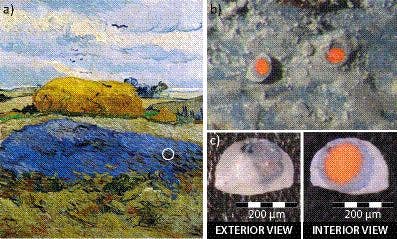Belgian scientists have revealed a refined explanation for the chemical process that’s currently degrading Vincent van Gogh’s famous paintings, which are losing their bright red. Like other old paintings, van Gogh’s works are losing their saturated hue because of the interaction between red led and light. Using sophisticated X-ray crystallographic methods, the researchers identified a key carbon mineral called plumbonacrite in one of his paintings, which explains the process even better.

Left: Van Gogh painting “Wheat Stack under a Cloudy Sky” (Kröller-Müller Museum, Netherlands). The paint sample area is indicated by a white circle. Upper right: Detail of the painting in the sample area, lower right: Detail of the paint sample (picture: Wiley-VCH Verlag GmbH & Co. KGaA, Weinheim)
All paints are made up of three key parts: the vehicle (usually water), the pigment (the stuff that gives matter color – usually mined from the earth in the form of clay or mineral or even plants, but also synthetic form), and a binder (otherwise you’d just have colored water – typically chalk is used). Red lead (minium, or lead (II,IV) oxide) is a lead oxide whose composition is Pb3O4 and whose color varies over time. It’s been a favorite pigment for thousands of years. In fact, it can still be found in the old cave paintings some 40,000 years old. Of course, it degrades over time darkening as the red lead pigment is converted to plattnerite (beta-lead dioxide) or galena (lead sulfide). At other times, the color will lighten or bleach due to the conversion of red lead to lead sulfate or lead carbonate.
A team led by Koen Janssens at the University of Antwerp investigated what makes van Gogh’s paintings turn white by taking a microscopic sample from “Wheat Stack under a Cloudy Sky”, one of his famous work, and subjecting it to crystallographic analysis. X-ray powder diffraction mapping and tomography techniques were employed to determine the spatial distribution of the various crystalline compounds found throughout the sample. They eventually found an unexpected compound, the very rare lead carbonate mineral called plumbonacrite (3 PbCO3·Pb(OH)2·PbO).
“This is the first time that this substance has been found in a painting from before the mid twentieth century,” reports Frederik Vanmeert, first author of the paper. “Our discovery sheds new light on the bleaching process of red lead.”
Considering this latest finding, the Belgian researchers proposed a chemical reaction pathway of the red lead under the influence of light and CO2, which ultimately altered the pigment and caused a color change in the painting. As light hits the paint (red lead and other pigments), the incoming energy causes electrons to move from the valance band to the conducting band in red lead, which is a semi-conductor. This reduces the red lead to PbO, which reacts with other products formed by the reaction of CO2 from the air with the degrading binding medium. Ultimately, this forms plumbonacrite as an intermediate that is converted to hydrocerussite and then to cerussite (lead carbonate). All these products are white, hence the lower saturation. The findings were reported in Angewandte Chemie.
Art aficionados shouldn’t fret too hard, though. Van Gogh’s paintings are still marvelous, despite more than a hundred years since the Dutch painter made his first stroke on the canvas. Museums give great care and employ special conservation methods to keep the old masters’ work bright and vibrant for hundreds of years to come.









